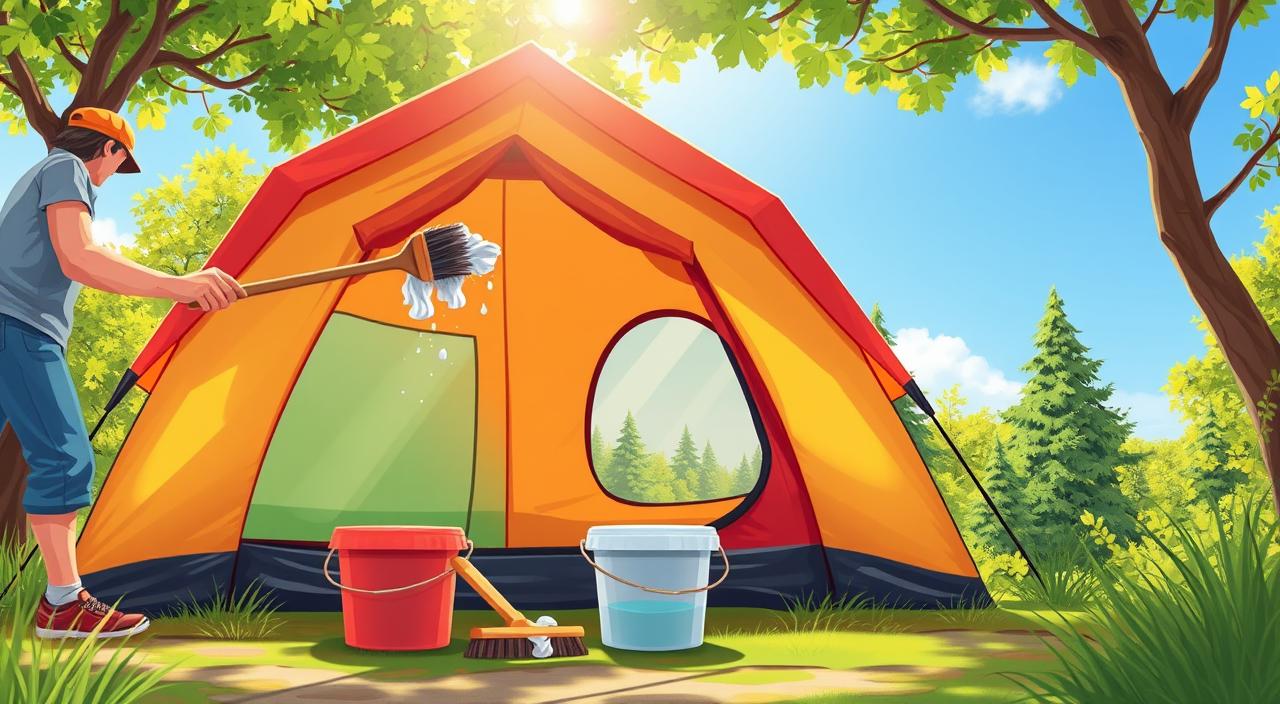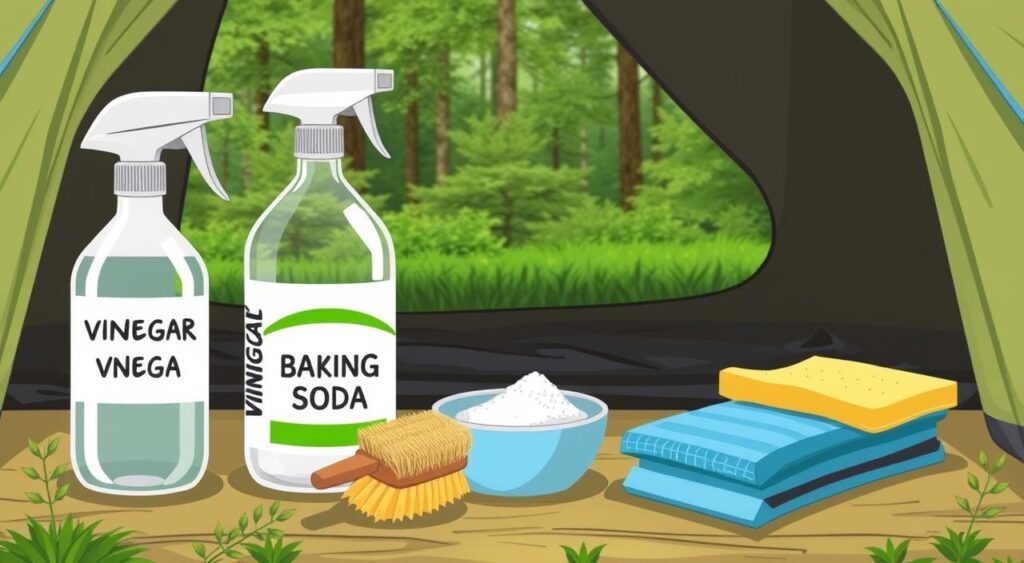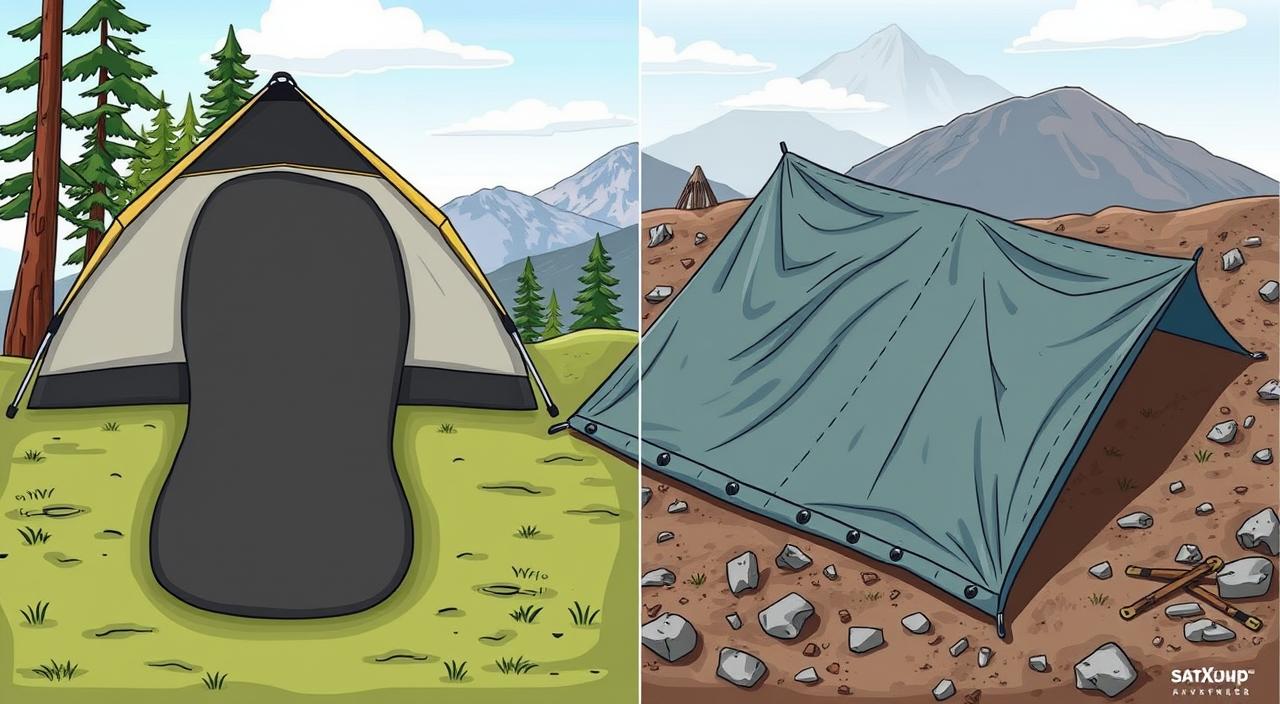
Disclaimer: This post may contain affiliate links. As an Amazon Associate, we earn from qualifying purchases.
Ever pulled your tent out of storage to find it covered in mildew? Don’t worry, you’re not out of luck yet! Mildew can ruin your tent and even harm your health. So, it’s important to tackle it fast. This guide will show you how to clean mildew from tent fabric and simple ways to clean your camping gear. Get your tent back to its best and enjoy camping again!
Key Takeaways
- Mildew is a common issue that can lead to unpleasant smells in tents.
- Handling mold and mildew quickly is essential for both your gear and your health.
- DIY solutions, like vinegar and lemon juice, can be effective against mildew.
- Proper storage and maintenance can help prevent mildew from returning.
- Hand washing your tent is the safest method to clean it without causing damage.
- Regular cleaning and waterproofing extend your tent’s lifespan.
Understanding the Causes of Mildew in Tents
Knowing why mildew grows in tents can make your camping trips cleaner and healthier. Mildew loves moist, warm, and dark places, making tents perfect spots for it. Not taking good care of your tent before and after trips can lead to mildew. By understanding this, you can stop mildew before it starts.
Common sources of mildew growth
Dirt, pet hair, and moisture are key to mildew’s growth. Here are some common causes:
- Damp clothing and gear inside the tent
- Condensation on tent walls
- Pet hair or sweat from sleeping inside
- Food spills not cleaned up
Checking for these can really cut down on mold in your gear.
How moisture contributes to mildew
Moisture is key for mold to grow. If you pack a wet tent, mildew is likely to follow. Rain and humidity add to the risk, especially in shaded spots with little air flow. Putting tents in sunny spots helps them dry out.
Regular checks for mildew are a must. If you find it, act fast to stop it from getting worse. This can save your tent from damage, tears, or even total loss.
| Factor | Impact on Mildew Growth |
|---|---|
| Moisture | Essential for mold formation; increases risk in wet conditions |
| Darkness | Creates a favorable environment for mold spores to flourish |
| Warmth | Accelerates mold development, especially in tents |
| Lack of Ventilation | Traps humid air, increasing mildew risk |
How to Clean Mildew from a Tent
Cleaning mildew from a tent can seem tough, but a step-by-step tent cleaning guide makes it easier. Start by getting the right tools and supplies for effective moldy tent fabric cleaning.
Step-by-Step Guide to Remove Mildew
Here are the steps to remove mildew from your tent:
- Set up your tent in a shaded area to protect it from direct sunlight.
- Prepare a gentle cleaning solution by mixing 2 fl oz (59 ml) of Revivex Pro Cleaner with warm water.
- Using a soft brush, apply the solution to the moldy areas, scrubbing gently to lift the mildew.
- Rinse the tent thoroughly with fresh water to eliminate any soap residue.
- Allow the tent to air dry for 6-8 hours, ensuring it is completely dried before storage.
Essential tools and supplies needed
Having the right tools makes cleaning easier. Here are the essential items you’ll need:
- Revivex Pro Cleaner
- Soft brush for scrubbing
- Dish towel for drying
- Bathtub or large container for soaking
- Isopropyl alcohol for treating PU odors
- Mild dish soap
- Seam Grip TF for canvas tents
For more severe mold, you might need to soak the tent. Knowing how to deal with mold makes camping trips better, keeping your gear in top shape.
Cleaning Techniques for Different Tent Types
Keeping your tent clean and in good shape is key for many camping trips. Different tents need special cleaning methods to stay in top condition. Learning how to remove mildew from your tent can make cleaning easier and save you time.
Best practices for canvas vs. polyester tents
Canvas tents are loved for their breathability and look. They need gentle care to stay in good shape. Here’s how to clean a canvas tent:
- Spot cleaning with mild soap and water.
- Using cleaning solutions made for canvas.
- Applying UV ray protection sprays to stop mold from coming back.
Polyester tents are strong and affordable, making them great for events. They have a waterproof PVC coating. Here’s how to clean them:
- Gently scrub with a soft brush and a mild solution.
- Stay away from rough materials that could scratch the tent.
- Clean stains right away.
How to handle pop-up tents
Pop-up tents are easy to set up but can get mildew if not looked after. To keep them in good shape, follow these steps:
- Wipe down the tent with a soft cloth right after use.
- Store the tent dry to stop mildew from growing, especially after it rains.
- For a deep clean, wash the fabric with mild soap and water but be gentle.
Following these cleaning tips will help you take care of your canvas, polyester, and pop-up tents. This way, they’ll last longer and stay in good condition. Always check the tent maker’s advice for the best care for your specific tent.
Effective Cleaning Solutions for Mildew Removal
Dealing with mildew on your tent can be tough. But, the right cleaning solutions can help. You can choose from DIY methods or specialized cleaners. Using safe solutions not only removes mildew but also protects your tent and the environment.
DIY solutions like vinegar and lemon juice
Many campers use vinegar and lemon juice for cleaning their tents. These items are safe and good for the planet. To make a simple cleaner, mix:
- 1 part distilled white vinegar
- 1 part water
- Optional: a sprinkle of baking soda for abrasive cleaning
This mix can remove mildew stains and get rid of bad smells. Apply it to the mildew spots, wait 30 minutes, then scrub with a soft brush. Rinse well after.
Specialized cleaners to consider
If you need stronger cleaners, try Revivex Pro Cleaner or Bass Pro Shops Mildew Stain Remover. Revivex Pro Cleaner works well for tough stains and deep cleaning. Use 2 fl oz per wash cycle.
For bad smells, mix isopropyl alcohol and water (1:3) for PU coatings. To keep your tent in good shape, use Revivex UV Protectant after cleaning. It protects against the sun and rain.

These products help manage mildew and keep your gear in good condition. Regular cleaning and maintenance can ensure a mildew-free camping trip.
| Cleaning Method | Estimated Time | Notes |
|---|---|---|
| Vinegar Solution (DIY) | 30 minutes | Safe and non-toxic |
| Revivex Pro Cleaner | 30 minutes for application | Effective for tough stains |
| Odor Eliminator Solution | 30 minutes | Neutralizes smells effectively |
| Air Drying After Cleaning | 6-8 hours | Ensure complete dryness to prevent mildew regrowth |
Preventing Mildew Growth on Your Tent
To enjoy camping without mildew worries, it’s important to prevent moisture buildup. Proper care and maintenance help avoid moisture in your tent. Follow these key tips for storing and caring for your tent after camping to keep it in great condition.
Storage tips to avoid moisture accumulation
Storing your tent right is crucial to prevent mildew. Start by drying your tent fully before packing it away. Here are some storage tips:
- Store your tent in a cool and dry spot to reduce mold risk.
- Use a ground tarp while camping to keep the tent floor dry and reduce condensation.
- Keep the tent clean by removing organic stuff that can cause mold.
- Retreat the canvas with waterproofing treatment every sixty days to keep it working well.
Post-camping care for your tent
After camping, take good care of your tent to make it last longer and prevent moisture buildup. Add these steps to your post-camping routine:
- Check seams and fix any leaks to keep them sealed right.
- Clean your tent with mild soap and hot water and a soft brush. Avoid bleach as it can weaken the fabric.
- Let your tent air dry fully before storing it. A dry tent prevents mildew and bad smells.
- Think about using Revivex UV Protectant to protect the tent fabric from the sun.
Removing Mildew Stains from Tent Fabric
Removing mildew stains from tent fabric can seem tough. But, with the right stain removal techniques for tents and some effort, you can make your gear look new again. This guide will show you how to clean stains, treat tough spots, and prevent future issues.
Spot cleaning techniques
Act fast if you see a mildew stain on your tent. Here’s how to clean it effectively:
- Prepare your cleaning solution: Mix 2 fl oz of Revivex Pro Cleaner with water. Make enough to cover the stain.
- Apply the solution: Use a brush or sponge to scrub the stain gently. Let the cleaner work its way into the fabric.
- Let it sit: Wait for about 30 minutes to let the solution break down the mildew.
- Rinse thoroughly: Clean the area with fresh water until all cleaner is gone.
- Air dry: Let the tent dry in the open air for 6-8 hours.
How to treat stubborn stains
For tough mildew stains, you’ll need more than spot cleaning. Here’s what to do:
- Soak the tent: If mildew covers a lot, soak the whole tent in a cleaning solution for 2-3 days. This lets the cleaner get deep into the fabric.
- Avoid harsh chemicals: Don’t use bleach because it damages canvas and can ruin the stitching.
- Use specialized products: Products like Revivex Odor Eliminator work well. Mix 1 fl oz with a gallon of water for best results.
- Monitor the fabric: Keep an eye on your tent for new stains. Catching them early helps prevent more damage.

Using these stain removal techniques for tents, you can keep your tent in good shape. This ensures you’ll have fun camping in the future. For more tips on cleaning and maintaining your tent, check out this link.
Eliminating Mildew Odors from Your Tent
Mildew odors can really ruin your outdoor fun. It’s key to find ways to get rid of these smells from your tent. Using natural methods can make your tent fresh and ready for the next trip. Cleaning right and using natural solutions can keep your tent smelling nice.
Natural deodorizing methods
Airing out your tent after use is a great way to get rid of mildew smells. Put your tent in a spot with good airflow and sunlight. UV rays help kill smells. Here are some other natural ways to keep your tent fresh:
- Use baking soda by sprinkling it inside your tent. Let it sit for a few hours to soak up bad smells.
- Try putting an open bowl of white vinegar in your tent overnight. It helps get rid of tough smells.
- Activated charcoal is great for soaking up moisture and smells in your tent.
Using camping equipment odor eliminators
Products like Revivex Odor Eliminator use natural ways to kill smells from bacteria and mold. Soaking your tent in a mix of this product can get rid of mildew smells. MiraZyme is another product that’s good for removing strong odors, keeping your gear smelling fresh. Always make sure your tent is dry before storing it to keep it smelling good.
Importance of Regular Tent Maintenance
Looking after your camping gear keeps it in top shape for many years. It’s key to make your tent last longer and improve your camping trips. Create a routine that fits your camping style and the weather you face.
How often should you clean your tent?
If you go camping just for short trips, clean your tent every few months. But, if you’re out for several days, clean it right after. This stops mildew and keeps your gear working well and looking good. For more tips, see the guide on tent care.
Benefits of maintaining your camping gear
Regular tent care has many perks:
- Enhanced durability: Right care means less wear and tear, making your tent last longer.
- Improved hygiene: Clean tents mean no bad smells or health issues from mold or mildew.
- Better camping experiences: A well-kept tent means more comfort and fun on your trips.
- Professional appearance: Clean tents look good and can attract more renters.
- Time-efficient solutions: Using professional cleaning saves time and ensures your tent is spotless.
Putting effort into regular tent care now means better camping trips later. Keeping your gear in good shape means more fun and comfort outdoors.

Long-Term Care for Your Tent
Looking after your tent is key to its lasting performance and quality. It’s important to know how to waterproof your gear after cleaning and store it right during the off-season. A well-kept tent keeps its strength and makes camping better.
How to waterproof your tent after cleaning
After a good clean, waterproofing your tent is the next step. It keeps moisture out and extends the fabric’s life. Here’s how to waterproof your camping gear:
- Use 2 fl oz (59 ml) of Revivex Pro Cleaner for a thorough clean.
- Then, apply a waterproofing spray made for your tent’s material. Make sure to follow the instructions carefully.
- Let the tent air dry fully to boost the waterproofing. This might take about 6-8 hours.
- To add extra protection, sprinkle new PU coating with baby or talcum powder once it’s dry. This prevents it from feeling sticky.
Storing your tent for the off-season
Storing your tent right is key for its long life. Here’s how to get your tent ready for the off-season:
- Make sure your tent is clean and dry before folding it up.
- Keep it in a cool, dry spot to stop moisture from building up. Don’t leave it where it might get damp.
- Think about using a storage bag instead of the original stuff sack. This keeps the tent’s shape and fabric in good condition.
By following these steps, you’ll protect your tent from mold and mildew. And it’ll be ready for your next camping trip!
Conclusion
Learning how to clean mildew from a tent is key to keeping it in good shape. This guide showed you how to stop mold before it starts, especially in canvas tents that breathe but can hold moisture. It’s important to act fast when you find mold to avoid tough stains and damage later.
Using things like vinegar, lemon juice, or special products like Mirazyme can keep your tent clean. Make sure your tent dries well after cleaning to stop mold from coming back. Airing out your tent and storing it right will keep your camping gear ready for your next trip.
By following these steps, you protect your investment and make your camping trips better. With the right care, you can have great outdoor adventures and keep your gear in top shape.









